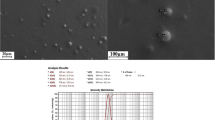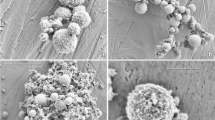Abstract
Expansion of the aquaculture industry has been accompanied by outbreaks of disease from an ever increasing range of pathogens. Such outbreaks pose serious limitations to the growth and sustainability of the seafood industry, necessitating the development of alternative methods to combat disease. Immunostimulants are currently being pursued as an effective alternative to the use of traditional antibiotics. However, for suspension feeding bivalves, an effective system whereby immunostimulants can be successfully delivered to the site of infection at appropriate times is lacking. In recent years, the process of microencapsulation using non-toxic and biodegradable coatings has been an effective and stable delivery system for the administration of probiotics. In this study, SMA microbeads encapsulated in alginate were used as a biological proxy for the delivery of immunostimulants to the European flat oyster, Ostrea edulis. Chitosan- and poly-l-lysine-coated and uncoated alginate microcapsules were used, and the route of intake and transportation to the various oyster tissue types was assessed histologically. Results demonstrated that bivalves readily ingest microalginates, which are broken up in the gut liberating the SMA microbeads. The SMA microbeads successfully cross the digestive epithelium and disperse into the surrounding tissue. The microbeads were also actively taken up by the oyster hemocytes. This study demonstrated that microencapsulation in alginate can serve as an efficient immunostimulant delivery system for bivalves, providing alternative treatment options for effective disease management and control.



Similar content being viewed by others
References
Arzul I, Gagnaire B, Bond C et al (2009) Effects of temperature and salinity on the survival of Bonamia ostreae, a parasite infecting flat oysters Ostrea edulis. Dis Aquat Org 85:67–75
Arzul I, Langlade A, Chollet B et al (2011) Can the protozoan parasite Bonamia ostreae infect larvae of flat oysters Ostrea edulis? Vet Parasitol 179:69–76
Balouet G, Poder M, Cahour A (1983) Haemocytic parasitosis: morphology and pathology of lesions in the French flat oyster, Ostrea edulis. Aquaculture 34:1–14
Bansal V, Sharma PK, Sharma N et al (2011) Applications of chitosan and chitosan derivatives in drug delivery. Adv Biol Res 5:28–37
Borgogna M, Bellich B, Cesàro A (2011) Marine polysaccharides in microencapsulation and application to aquaculture: “From Sea to Sea”. Mar Drugs 9:2572–2604
Campa-Córdova AI, Hernández-Saavedra NY, De Philippis R et al (2002) Generation of superoxide anion and SOD activity in haemocytes and muscle of American white shrimp (Litopenaeus vannamei) as a response to β-glucan and sulphated polysaccharide. Fish Shellfish Immunol 12:353–366
Canesi L, Ciacci C, Fabbri R et al (2011) Bivalve molluscs as a unique target group for nanotoxicity. Mar Environ Res 76:1–6
Chang CF, Su MS, Chen HY et al (2003) Dietary β-1,3-glucan effectively improves immunity and survival of Penaeus monodon challenged with white spot syndrome virus. Fish Shellfish Immunol 15:297–310
Cognie B, Barillé L, Rincé Y (2001) Selective feeding of the oyster Crassostrea gigas fed on a natural microphytobenthos assemblage. Estuaries 24:126–134
Costa MM, Novoa B, Figueras A (2008) Influence of β-glucans on the immune responses of carpet shell clam (Ruditapes decussatus) and Mediterranean mussel (Mytilus galloprovincialis). Fish Shellfish Immunol 24:498–505
Culloty SC, Novoa B, Pernas M et al (1999) Susceptibility of a number of bivalve species to the protozoan parasite Bonamia ostreae and their ability to act as a vector for this parasite. Dis Aquat Org 37:73–80
Evan Ward J, Shumway SE (2004) Separating the grain from the chaff: particle selection in suspension -and deposit-feeding bivalves. J Exp Mar Biol Ecol 300:83–130
Friedman C, Perkins F (1994) Range extension of Bonamia ostreae to Maine, USA. J Invert Pathol 64:179–181
Gram L, Melchiorsen J, Spanggard B et al (1999) Inhibition of Vibrio anguillarum by Psuedomonas fluorescens AH2, a possible probiotic treatment of fish. Appl Environ Microbiol 65:969–973
Heppel J, Davis HL (2000) Application of DNA vaccine technology to aquaculture. Adv Drug Deliv Rev 43:29–43
Kesarcodi-Watson A, Heinrich K, Lategan MJ et al (2008) Probiotics in aquaculture: the need, principles and mechanisms of action and screening processes. Aquaculture 274:1–14
Lee KY, Heo TR (2000) Survival of Bifidobacterium longum immobilized in calcium alginate beads in simulated gastric juices and bile salt solution. Appl Environ Microbiol 66:869–873
Lees D (2000) Viruses and bivalve shellfish. Int J Food Microbiol 59:81–116
Li J, Li Y, Dong H (2008) Controlled release of herbicide acetochlor from clay/carboxylmethilcellulose gel formulations. J Agric Food Chem 56:1336–1342
Lynch S, Mulcahy MF, Culloty SC (2008) Efficiency of diagnostic techniques for the parasite, Bonamia ostreae, in the flat oyster, Ostrea edulis. Aquaculture 281:17–21
Lynch SA, Abollo E, Ramilo A et al (2010) Observations raise the question if the Pacific oyster, Crassostrea gigas, can act as either a carrier or a reservoir for Bonamia ostreae or Bonamia exitiosa. Paritisology 137:1515–1526
Martínez Cruz P, Ibáñez AL, Monroy Hermosillo OA et al (2012) Use of probiotics in aquaculture. ISRN Microbiology 2012(2012):1–13. Article ID 916845, doi:10.5402/2012/916845
Meena DK, Das P, Kumar S et al (2013) Beta-glucan: an ideal immunostimulant in aquaculture (a review). Fish Physiol Biochem 39(3):431–457. doi:10.1007/s10695-012-9710-5
Pales Espinosa EP, Barille L, Allam B (2007) Use of encapsulated live microalgae to investigate pre-ingestive selection in the oyster Crassostrea gigas. J Exp Mar Biol Ecol 343:118–126
Pales Espinosa EP, Perrigault M, Ward JE et al (2009) Lectins associated with the feeding organs of the oyster Crassostrea virginica can mediate particle selection. Biol Bull 217:130–141
Plant KP, LaPatra SE (2011) Advances in fish vaccine delivery. Dev Comp Immunol 35:1256–1262
Polk AE, Amsden B, Scarratt DJ, Gonzal A, Okhamafe AO, Goosen MFA (1994) Oral delivery in aquaculture: controlled release of proteins from chitosan-alginate microcapsules. Aquac Eng 13:311–323
Reyes-Becerril M, Tovar-Ramírez D, Ascencio-Valle F et al (2008) Effects of dietary live yeast Debaryomyces hansenii on the immune and antioxidant system in juvenile leopard grouper Mycteroperca rosacea exposed to stress. Aquaculture 280:39–44
Riisgard HU (1988) Efficiency of particle retention and filtration rate in 6 species of northeast American bivalves. Mar Ecol Prog Ser 45:217–223
Ringø E (2012) Use of immunostimulants and nucleotides in aquaculture: a review. J Mar Sci Res Dev 2:104
Rodgers CJ, Furones MD (2009) Antimicrobial agents in aquaculture: practice, needs and issues. Options Méditerranéennes 86:41–59
Rokka S, Rantamäki P (2010) Protecting probiotic bacteria by microencapsulation: challenges for industrial applications. Eur Food Res Technol 231:1–12
Rosas-Ledesma P, León-Rubio JM, Alarcón FJ et al (2012) Calcium alginate capsules for oral administration of fish probiotic bacteria; assessment of optimal conditions for encapsulation. Aquac Res 43:106–116
Shaw BL, Brittle HI (1957) The gross and microscopic anatomy of the digestive tract of the oyster Crassostrea virginica (Gmelin). Can J Zool 67:191–194
Skjermo J, Vadstein O (1999) Techniques for microbial control in the intensive rearing of marine larvae. Aquaculture 177:333–343
Smith VJ, Brown JH, Hauton C (2003) Immunostimulants in crustaceans: does it really protect against infection? Fish Shellfish Immunol 15:71–91
Tafalla C, Gómez-León J, Novoa B et al (2003) Nitric oxide production by carpet shell clam (Ruditapes decussatus) hemocytes. Dev Comp Immunol 27:197–205
Vine NG, Luekes WD, Kaiser H (2006) Probiotics in marine larviculture. FEMS Microbiol 30:404–427
Winkel EH, Davids C (1982) Food selection by Dreissena polymorpha Pallas (Mollusca: Bivalvia). Freshwater Biol 12:553–558
Acknowledgments
The authors would like to thank the shellfish growers who contributed material for the study. The project BEADS (Bioengineered micro-encapsulation of active agents delivered to shellfish) was funded by the Seventh EU Framework Programme (FP7).
Author information
Authors and Affiliations
Corresponding author
Rights and permissions
About this article
Cite this article
Darmody, G., Maloy, A.P., Lynch, S.A. et al. Tissue targeting of the European flat oyster, Ostrea edulis, using microencapsulated microbeads as a biological proxy. Aquacult Int 23, 647–659 (2015). https://doi.org/10.1007/s10499-014-9842-y
Received:
Accepted:
Published:
Issue Date:
DOI: https://doi.org/10.1007/s10499-014-9842-y




